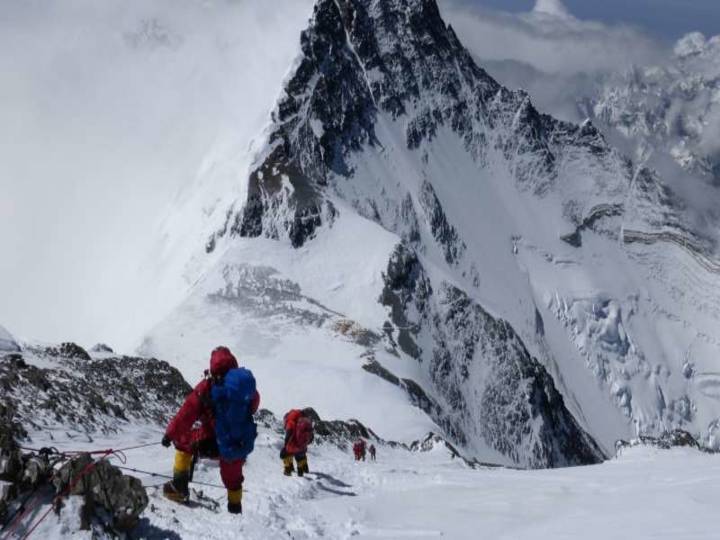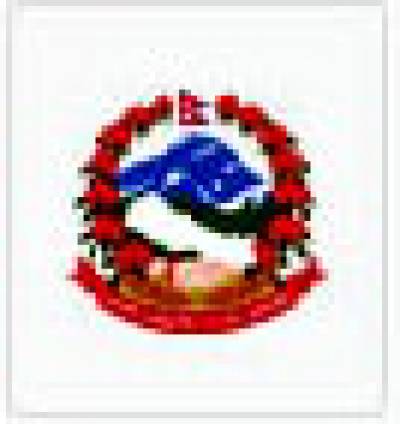EVEREST EXPEDITION (SOUTH)
At number one on a climber’s bucket list: “I climbed the highest mountain in the world (8848m/29,028ft)”. Edmund Hillary said, “It is not the mountain we conquer but ourselves”. The Everest Expedition is a challenge that many climbers cannot resist. Everest is known in Nepali as Sagamartha -meaning “forehead in the sky”. In Tibetan, it is known as Chomolungma meaning “Saint Mother”. Climbing Everest requires every skill in the book to reach the summit; hence it is not for everyone. You will need untold endurance, strength and technical skills to pursue this goal. The weather is fickle and often unpredictable; the risks are high and the emotional challenge is testing. One of the main reasons for failure, besides adverse weather conditions, is altitude sickness, which fortunately can be minimized with the right preparation. The other reason is due to avalanches. Everest, at 8848m, requires expert planning and logistical support in order for you to succeed. Sherpa Expedition & Trekking has more than 40 years in the trekking and climbing field and know exactly how to make this assault on the summit a success.
There are two faces and routes that climbers most frequently follow to the summit. The North Face is reached from Tibet, while the South Face can be reached from within Nepal. Our route to the summit will be from the South Face, considered more dangerous than the North Face, due to having to cross the Khumbu Icefall where most tragedies have occurred. However, some say it is easier due to the absence of the ladders and climbing over the rock on the steep steps on the North Face. Annapurna is still the deadliest of the 8000m peaks, with one death for every four summits. Cho Oyu is the safest 8000m peak to climb. More recent times have decreased the number of deaths of climbers on Everest. This can be put down to better equipment, improved weather forecasting, and climbers using professional climbing organizations, such as Sherpa Expedition & Trekking.
Base camps are at Camp I (6,065m) within view of the Khumbu Glacier, and then another 450m to Camp II (6,500m) and a further 610m to Camp III (7,200m) located at the head of Lhotse. From Camp III you will need oxygen. Camp IV (7,910m) is the final camp before the peak. From here on is referred to as the death zone. These base camps are stepping stones to the summit, allowing you time to acclimatize by frequently ascending and descending, all the while honing your skills prior to the final push to the summit. Three significant points on your way to the summit are the Khumbu Icefall, the Yellow Band, and ascend the Hillary Step, a near-vertical rock face with about 12 meters not far from the summit at approximately 8,790 meters (28,839 ft). The Khumbu Glacier is still the most dangerous section of the route due to crevasses and the forever moving ice.
The Mount Everest Expedition is without a doubt a once in a lifetime opportunity. However, there are inherent dangers in climbing Everest, such as previously mentioned, altitude sickness, as well as severe weather conditions and avalanches. Anyone considering this climb should have several 600m or 7000m climbs under their belt. You must be familiar with all aspects of using the equipment of high altitude expeditions. You will also need to be extremely fit, both physically and mentally. Prior to heading to Everest, it is advised that you strengthen your cardiovascular system and physical strength. At these high altitudes, oxygen levels drop around 60-70 percent compared to sea level. You will also be required to carry a large pack containing oxygen and other equipment
Everest was first referred to as Peak XV and was later named Mt. Everest after the lead surveyor Sir George Everest who surveyed the mountain in 1856. It wasn’t until May 25, 1960, that New Zealander Edmund Hillary and Nepali Sherpa, Tenzing Norgay finally reached the summit via the south route. The first summit via the north route was accomplished by a group of Chinese climbers.
Sherpa Expedition and Trekking’s Sherpa guides (well known worldwide for their climbing skills) will do everything within their power to lead you safely to the summit. Our guides are government certified and experienced climbers. We take no chances with your well-being and hence have allowed several days to make up for unforeseen circumstances, such as adjusting to higher altitudes and the possibility of altitude sickness. As for the weather, well that is truly in the “Hands of the Gods.”
ITINERARY
Day 1 : Arrival in Kathmandu Airport and transfer to hotel Yak and Yeti or similar hotel accommodation in Kathmandu (1350M/4430ft)
Day 2 - 3 : Preparation, Briefings at Departments of tourism, Last minute shopping
Day 4 : Flight from Kathmandu to Lukla; Trek to Phakding (2650m/8694ft, 04 hrs); lodge accommodation.
Day 5 : Trek from Phakding to Namche Bazaar through colorful Khumbu villages (3440m/11286ft, 06hrs); Lodge accommodation.
Day 6 : Rest day for acclimatization; you will be hike to famous Everest View Hotel (3800m/12487ft, 3hrs) to catch a glimpse of Everest; explore Hilary and Sherpa museum at Namche in the evening with slide show program.
Day 7 : Trek from Namche Bazaar to Tyangboche (3850m/12631ft, 05-06 hrs); visit significant Buddhist monastery; lodge accommodation.
Day 8 : Trek from Tyangboche to Dingboche (4350m/14271ft, 4hrs) about 4-5hrs; catch glimpses of Ama Dablam and Lhotse; lodge accommodation.
Day 9 : Acclimatization in Dingboche(4350M/14271ft) hiking up to chhukung-re.
Day 10 : Trek from Dingboche to Lobuche (5018m/16463ft, 4-5hrs); lodge accommodation.
Day 11 : Trek from Lobuche to Gorakshep (5170m/16962ft, 3hrs); lodge accommodation.
Day 12 : Morning acclimatize to Kalapathar (5554M) after breakfast Trek from Gorakshep to Everest Base camp (5200m/17060, 2hrs.
Day 13 - 58 : Climbing period Summit Everest (8,848m/ 29029ft)
Day 59 : Preparation for return, trek from Everest base camp to Dingboche(4350m/14271ft, 4hrs) , lodge accommodation
Day 60 : Trek from Dingboche to Tengboche (3860m/12631ft, 04 hours) lodge accommodation
Day 61 : Trek from Tengboche to Namche Bazaar (3440m/11286ft, 04hrs) lodge accommodation.
Day 62 : Trek from Namche Bazaar to Lukla(2840m/9317ft,7hrs) lodge accommodation
Day 63 : Fly from Lukla to Kathmandu (1350M/4430ft); 35minutes, transfer to hotel
Day 64 : Leisure day & shopping in Kathmandu; Fair well-Celebration dinner with culture program in the Evening.
Day 65 : Transfer to the airport for final departure
SERVICES
Full Board Service Includes
- Arrival and departure transfer services to Domestic flight as per itinerary.
- Assistance at the International airport by Shera Expedition and Trekking while arriving and departing in Kathmandu.
- 4 Nights 5-star category hotels accommodation in Kathmandu on B/B basis.
- Experienced and government licensed high altitude trekking and climbing guide during the trekking and climbing period.
- Schedule Flight Tickets for Kathmandu-Lukla-Kathmandu sector to all climbing member, Sherpa guide, liaison officer and kitchen staff.
- All trekking and mountaineering equipment like; kitchen tent, stores tent, dining tents, toilet tents, tables, chairs, and cooking utensils for advance Base Camp and camp two.
- Common climbing equipment (necessary fixed and main rope, ice bars, ice screws, snow bar etc)
- Services of cook and kitchen boy at Base Camp and cook at Camp 2
- 3 meals a day (Breakfasts, Lunch, and Dinners with tea/ coffee) in available tea house/hotel/lodge during the trekking
- 3 fresh meals a day (Breakfasts, Lunch, and Dinners) will be served at base camp, and camp two.
- All food and fuel for Base Camp and higher camps during the expedition for both members and crews.
- Per person 60kg baggage allowance during trekking-up carrying by porter or Yak to climbing the Mt. Everest.
- Daily Weather Report Services from Seattle based
- Trekking Permit (Everest National Park entry fee)
- TIMS card (Trekking Information Management System).
- Expedition Royalty and climbing permit of Nepal Government to climb Mt. Everest (8848M).
- Nepalese Government Royalty and fees;
- One Experienced, Trained, Government Licensed, and 03 Times Everest Summiteers Climbing/expedition Guide (Sherpa) per client.
- All wages, equipment, medical and accidental Insurances for all involved staffs in trekking and expedition.
- Medical consultation services at the base camp with the HRA clinic at the base camp.
- Equipment allowances and wages for Climbing Sherpa’s, cooks, kitchen boys.
- Equipment allowances and wages for Government Liaison Officer.
- First Aid medical kits for the Group and the staffs.
- Satellite phone carrying by Guide for communication and available for members with the cost of US$ 3 per minute call.
- Appropriate food for high altitude and all climbing crew at base camp and above as required.
- Required fixed and dynamic rope during the climbing period.
- The heater will be provided at base camp for heating the dining room.
- Emergency Oxygen, mask, and regulator provided on requirement of guest with appropriate charge
- Each expedition member will have an individual tent available in the ABC.
- Solar panel for light and battery charger.
- All tents for camp 1, 2, 3 and 4 for members and staff.
- Icefall charges by Sagarmatha Pollution Control Committee.
Full Board Service Excludes
- Lunch and Dinner during your stay in Kathmandu (except for the farewell dinner)
- Any packed food/snacks, aerated drinks, energy drinks, mineral water, alcohol, cigarettes, chocolates, nutria-bars during the trekking.
- Items of personal nature, Laundry Expenses, Tips.
- Any extra expenses arising out of various/unforeseen situations like natural calamities, landslides, political disturbances, strikes, changes in Government regulations, etc.
- Extra transportation then display in the itinerary program.
- Any additional staff other than specified.
- Rescue, Repatriation, Medicines, Medical Tests and Hospitalization expenses.
- Medical Insurance and emergency rescue evacuation if required.
- Travel Insurance and helicopter rescue.
- Wallie-talkies & Filming permit (if the special camera or walkies-talkies).
- Personal climbing gears;
- Expenses incurred towards usage of landlines, mobiles, walkie-talkies or satellite phone And Internet expenses
- Clothing, Packing Items or Bags, Personal Medical Kit, Camera/Video Fees or Trekking Gears
- Nepal custom duty for import of expedition goods.
- Summit bonus for climbing Sherpa Guides as per Mountaineering Association rules. Minimum US$ 1500.00 per climbing Sherpa guide.
- Tips and gifts for base camp and high altitude trekking and climbing staff are mandatory.
- Airfare of international flights.
- Nepal entry visa fee (easy to obtain the visa on arrival at Tribhuvan International Airport – Kathmandu). $30 USD for 15-day, $50 USD for 30 Days, and $125 USD for 90 Days visa.
- Any extra services or products or offers or activities which are not mentioned in the itinerary.
- Any other item not included in the cost includes section.
EQUIPMENTS
Travel Documents
- Valid Passport
- Credit Cards
- Pp Size Photo (4 Pieces)
- Insurance Paper And Contact Address.
- Family Members / Company’s Contact Address
Foot Wear
- Kailas / Lasportiva / Millet (Summit Shoe)
- Normal Socks (5-6 Pairs)
- Summit Socks (2 Pairs)
- Trekking Shoes (1 Pair)
- Camp Booties (1 Pair)
- Basecamp Slipper (1 Pair)
Upper Body
- Light Weight Top / Thermo Coat (2-3 Layers)
- Mid Weight Top (2-3 Layers)
- Heavy Weight Top (2 Layers)
- Fleece Jacket (1)
- Gore Text Jacket (1)
- Down Jacket (1)
- Wind Proof Jacket
- Cotton T-Shirt For Base Camp. (2-3)
Lower Body
- Light Weight Long Under Pants (2-3 Pairs)
- Under Wear (5-7 Pairs)
- Mid Weight Long Under Pants (2-3 Pairs)
- Heavy Weight Long Under Wear
- Gore Text Pant. (1)
- Down Pants. (1)
- Water Proof Pant. (1)
Head
- Sun Cap
- Desert Cap
- Balaclava
- Fleece Hat
- Neck Gaiter (2-3)
Hands
- Thin Fleece Gloves (2 Pairs)
- Wind Stopper Fleece Gloves
- Heavy Gloves (Mitten)
- Summit Gloves
Sleeping Bags
- Sleeping Bag - 20 Degree Celsius (For Base Camp)
- Down Sleeping Bag - 20 To -40 Degree Celsius (Extreme Comfort)
- Thermarest Mattress (Cell Foam)
- Thermarest Mattress (Inflatable)
Climbing Equipment
- Climbing Helmet
- Down Suit (Kailas / Marmot / Mountain
- Hardware / North Face / Millet )
- Crampons (Fit with Boot)
- Ice Axe
- Harness
- Atc Guide
- Jummer / Ascender
- Lock Carabiner (3)
- Unlock Carabiner (3)
- Tape Slings (2)
- Prusik Loops (1)
- Snow Goggle
- Head Light (4 Pairs Rechargeable Batteries Recommended)
- Satellite Phone
- Hand Warmer (If Possible)
Bag Packs
- Rucksacks 45L - 55L
- Duffle Bag 90 L -120 L (2 Pieces)
- Water Proof Stuff Sacks Large (2 Pieces)
- Water Proof Stuff Sacks Small (2 Pieces)
Sun Stuffs
- Banana Boat/ Nivea Sun Cream -50 (Spf)
- Lip Guard -20 / -50 (Spf)
- Sun Glasses (UV Protection)
- Glaciers Glasses (UV Protection)
Toiletries
- Hand Disinfectant
- Wet Tissue
- Toothpaste
- Toothbrush
- Soap
- Shampoo
- Garbage Bag
Eating & Drinking
- Water Bottle (2)
- Thermos
- Mug
- Spoon/ Fork
- Bowl
Medical
- Brufen / Ibuprofens
- Antibiotic
- Diamox
- Paracetamol
- Handy Plaster
- Crack Bandage
- Tincture Iodine
Miscellaneous
- Walking Stick
- Pocket Knife (Swiss)
- Umbrella / Rain Coat
GOOD TO KNOW
Here are some important things to know about an Everest Expedition:
1. Physical Fitness: Climbing Mount Everest is a physically demanding and challenging endeavor. It is crucial to be in excellent physical condition and have prior experience in high-altitude mountaineering. Regular cardiovascular exercises, strength training, and endurance-building activities are essential to prepare your body for the expedition.
2. Climbing Experience: Climbing Mount Everest requires prior experience in high-altitude mountaineering. It is recommended to have successfully climbed peaks above 6,000 meters (19,685 feet) and have experience with technical climbing skills, including using crampons, ice axes, and ropes.
3. Permits: Climbing Mount Everest requires obtaining permits from the Nepali government. These permits include the Everest climbing permit, Sagarmatha National Park entry permit, and Khumbu Rural Municipality permit. It is important to work with a reputable mountaineering agency that can assist you in obtaining the necessary permits.
4. Climbing Route: The most popular climbing route on Mount Everest is the South Col route from the Nepalese side. This route is known for its challenges and is attempted by the majority of climbers. Other routes, such as the North Ridge from the Tibetan side, are less crowded but require additional logistical arrangements.
5. Climbing Season: The climbing season for Mount Everest is typically in the spring (April-May) and autumn (September-November). These seasons offer more stable weather, fewer storms, and better climbing conditions. It is advisable to plan your expedition during these times to increase your chances of success.
6. Acclimatization: Proper acclimatization is crucial when climbing Mount Everest. It involves gradually ascending to higher altitudes, allowing your body to adapt to the reduced oxygen levels. This process helps minimize the risk of altitude sickness and improves your chances of reaching the summit. Acclimatization periods are built into the expedition schedule.
7. Sherpas and Guides: Hiring experienced Sherpas and guides is highly recommended for a successful Everest Expedition. Sherpas are local experts who have extensive knowledge of the mountain, its routes, and the challenges it presents. They provide crucial support, help with logistics, and ensure the safety of climbers.
8. Safety Considerations: Climbing Mount Everest involves inherent risks, including altitude sickness, avalanches, extreme weather conditions, and crevasses. It is essential to be aware of these risks and take necessary precautions. Following the guidance of experienced guides, using proper equipment, and being prepared for emergencies are essential for safety.
9. Environmental Responsibility: Mount Everest is a fragile environment, and climbers should practice responsible mountaineering. Follow the principles of Leave No Trace, respect the local culture and customs, and dispose of waste responsibly. Minimize your impact on the mountain and preserve its natural beauty.
10. Mental Preparation: Climbing Mount Everest is as much a mental challenge as a physical one. It requires perseverance, mental strength, and the ability to handle adversity. Prepare yourself mentally for the long and arduous journey, as well as the potential difficulties and setbacks you may encounter.
Embarking on an Everest Expedition is a significant undertaking that requires careful planning, preparation, and experience. Working with a reputable mountaineering agency and experienced guides is crucial for a safe and successful climb. Respect the mountain, embrace the challenge, and enjoy the incredible experience that climbing Mount Everest offers.
MAP
PHOTOS/Videos
Departures
Select a departure month
Fill out the form below and a Travel Expert will reach out to create your perfect tour.
FAQS
How long does it take to climb Mount Everest?
The duration of an Everest Expedition varies depending on several factors, including the climbing route, weather conditions, and individual climber's abilities. On average, it takes around 60 days from arrival in Nepal to reaching the summit and returning to base camp. This timeframe includes acclimatization periods, rest days, and potential weather delays.
How much does it cost to climb Mount Everest?
The cost of climbing Mount Everest can vary significantly depending on various factors, such as the climbing route, the level of support provided by the agency, the number of climbers in the group, and the services included. On average, the cost can range from $30,000 to $100,000 or more. It is essential to choose a reputable and experienced mountaineering agency that provides transparent pricing and covers all necessary services.
Do I need prior mountaineering experience to climb Mount Everest?
Yes, prior mountaineering experience is essential to climb Mount Everest. It is recommended to have successfully climbed peaks above 6,000 meters (19,685 feet) and have extensive experience in high-altitude mountaineering. Climbers should be skilled in using mountaineering equipment, have knowledge of rope techniques, and be familiar with glacier travel and crevasse rescue.
What permits do I need for an Everest Expedition?
To climb Mount Everest, you need to obtain several permits. These include the Everest climbing permit, Sagarmatha National Park entry permit, and Khumbu Rural Municipality permit. Your chosen mountaineering agency will assist you in obtaining these permits, as they are required for legal and safety reasons.
Is it possible to climb Mount Everest without a guide?
While it is technically possible to climb Mount Everest without a guide, it is highly discouraged, especially for climbers without significant experience. Climbing Everest is an extremely challenging and dangerous undertaking that requires expert knowledge, logistical support, and the assistance of experienced Sherpas and guides. Hiring a reputable mountaineering agency with experienced guides greatly increases your chances of a safe and successful climb.
How dangerous is climbing Mount Everest?
Climbing Mount Everest is considered one of the most dangerous mountaineering endeavors due to the extreme altitude, unpredictable weather conditions, and the risks associated with high-altitude climbing. Hazards include altitude sickness, avalanches, crevasses, and extreme cold. However, with proper preparation, training, and experienced guidance, the risks can be minimized. It is crucial to prioritize safety and follow the guidance of experienced climbers and mountaineering agencies.
How do I train for an Everest Expedition?
Training for an Everest Expedition requires a combination of cardiovascular exercises, strength training, endurance-building activities, and altitude training. Regular hiking, running, cycling, swimming, and weightlifting can help improve your overall fitness. It is also recommended to spend time at higher altitudes, such as climbing other high peaks, to acclimatize your body to reduced oxygen levels.
What is the best time to climb Mount Everest?
The best time to climb Mount Everest is typically in the spring (April-May) and autumn (September-November). These seasons offer more stable weather, fewer storms, and better climbing conditions. The spring season is considered the primary climbing season, with more expeditions attempting the summit during this time. However, weather conditions can vary, so it is important to consult with experienced climbers or mountaineering agencies for the most up-to-date information.
How do I choose a reputable mountaineering agency for an Everest Expedition?
Choosing a reputable mountaineering agency is crucial for a safe and successful Everest Expedition. Look for agencies with a proven track record, experienced guides, positive reviews from previous climbers, transparent pricing, and a focus on safety and ethical climbing practices. It is recommended to research multiple agencies, communicate with them directly, and ask for references before making a decision.
Latest Traveller’s Reviews
Travel experiences of our clients who recently returned from their trips.
100%
Based On 4 Reviews
Olivia Taylor
Finland
July 4, 2023
An Unforgettable Journey to the Roof of the World
I recently had the incredible opportunity to summit Mount Everest from the south side in Nepal, and I must say that it was an experience of a lifetime. This review is dedicated to the Sherpa Expedition Guide who made this expedition not only possible but also incredibly enjoyable and safe. From the moment we arrived in Kathmandu, our guide was there to greet us with a warm and welcoming smile. He took care of all the logistics, including permits, transportation, and accommodation, ensuring that our focus remained solely on the climb ahead. His attention to detail and thoroughness were evident throughout the entire journey. As we embarked on our trek towards Everest Base Camp, our guide proved to be not only knowledgeable but also an excellent motivator. He shared fascinating stories about the mountain, its history, and the Sherpa culture, which added a deeper level of appreciation to our adventure. His expertise and experience instilled confidence in our abilities and kept us motivated even during the most challenging moments. The ascent to the summit of Mount Everest was undoubtedly the highlight of the entire expedition. Our guide's careful planning and strategic acclimatization schedule allowed us to gradually adapt to the high altitude, minimizing the risk of altitude sickness. His constant monitoring of our physical condition and mental state ensured our safety at all times. The views from the summit were simply breathtaking. Standing on top of the world, surrounded by majestic peaks and vast glaciers, was a humbling experience that words cannot fully describe. Our guide made sure we had ample time to soak in the beauty and capture memories that will last a lifetime. In conclusion, I cannot recommend our Sherpa Expedition Guide highly enough. His professionalism, expertise, and genuine care for our well-being made this journey to the summit of Mount Everest an unforgettable one. If you are considering embarking on this extraordinary adventure, I strongly recommend choosing a guide who possesses the qualities and skills that our guide demonstrated. You will not be disappointed.
Karen Carter
United Kingdom
May 28, 2022
Unforgettable Memories and Unparalleled Expertise
Embarking on a summit of Mount Everest from the south side in Nepal was a dream that I had nurtured for years. Little did I know that this dream would turn into a reality beyond my wildest expectations, thanks to our Sherpa Expedition Guide. From the moment we met our guide, his warmth and enthusiasm set the tone for the entire expedition. He exuded a wealth of knowledge and experience that immediately instilled confidence in our team. His meticulous planning and attention to detail were evident in every aspect of the journey, ensuring a smooth and enjoyable experience for all. The trek to Everest Base Camp was an adventure in itself. Our guide's expertise and familiarity with the terrain allowed us to navigate through challenging trails with ease. Along the way, he shared captivating stories about the mountains, the Sherpa culture, and the history of Everest, making our journey all the more immersive and meaningful. As we began the ascent towards the summit, our guide's leadership and guidance were invaluable. He closely monitored our physical condition, providing guidance on acclimatization techniques and ensuring our safety at all times. His ability to assess the changing weather conditions and adjust our schedule accordingly was a testament to his experience and expertise. Reaching the summit of Mount Everest was a moment that will forever be etched in my memory. The breathtaking views that unfolded before us were beyond imagination. Our guide allowed us ample time to soak in the beauty, capturing photographs and memories that will be cherished for a lifetime. In conclusion, our Sherpa Expedition Guide was instrumental in making this journey to the summit of Mount Everest a resounding success. His professionalism, knowledge, and genuine care for our well-being were unwavering throughout the entire expedition. If you are seeking an unforgettable adventure with unparalleled expertise, I strongly recommend choosing a guide like ours. You will not be disappointed.
Olayemi Jemine
Canada
June 1, 2021
A Life-Changing Adventure with Breathtaking Views
Embarking on an expedition to summit Mount Everest from the south side in Nepal was a dream come true, and I owe a significant part of the success and enjoyment of this journey to our Sherpa Expedition Guide. His expertise, professionalism, and passion for the mountains were evident in every aspect of the trip. Right from our initial meeting in Kathmandu, our guide went above and beyond to ensure that our experience would be nothing short of extraordinary. He provided us with detailed information about the climb, the equipment we would need, and the physical and mental preparations required. His attention to detail and thoroughness were truly commendable. Throughout the trek to Everest Base Camp, our guide's knowledge of the terrain and the local culture enriched our experience. He shared fascinating stories about the Sherpa people, their traditions, and their relationship with the mountains. This added a whole new dimension to our journey and deepened our appreciation for the challenges that lay ahead. When it came time to ascend to the summit, our guide's expertise truly shone. He meticulously planned our climbing schedule, taking into account the unpredictable weather conditions and the best times to maximize our chances of a successful summit. His ability to adapt to changing circumstances and make well-informed decisions ensured our safety and well-being throughout the expedition. Reaching the summit of Mount Everest was an indescribable achievement. The views from the top were simply awe-inspiring. Surrounded by peaks piercing through the clouds, we felt like we were on top of the world. Our guide allowed us ample time to savor this incredible moment and capture memories that will stay with us forever. In conclusion, I cannot recommend our Sherpa Expedition Guide enough. His professionalism, knowledge, and genuine care for our well-being were evident every step of the way. If you are considering embarking on a journey to summit Mount Everest, I strongly recommend choosing a guide who possesses the qualities and skills that our guide demonstrated. The experience will be truly life-changing.
People Considering This Package Right Now Check availability
























